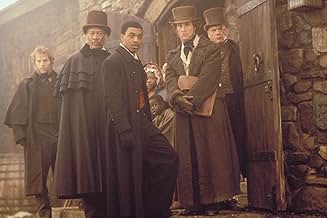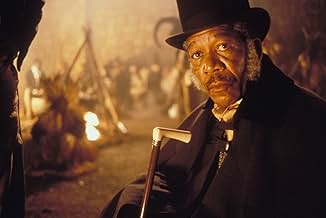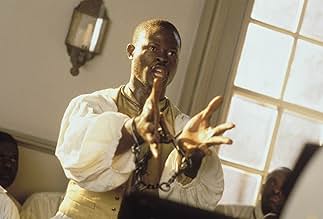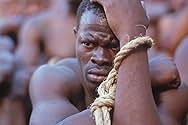एमीस्टैड एक १८३९ बगावत दास जहाज़ के बारे में है, जो अमेरिका के पूर्वोत्तर तट की ओर यात्रा कर रहा है। अधिकांश कहानी में दास के बारे में एक अदालत के कमरे का नाटक शामिल है जिसने इस विद्रोह का न... सभी पढ़ेंएमीस्टैड एक १८३९ बगावत दास जहाज़ के बारे में है, जो अमेरिका के पूर्वोत्तर तट की ओर यात्रा कर रहा है। अधिकांश कहानी में दास के बारे में एक अदालत के कमरे का नाटक शामिल है जिसने इस विद्रोह का नेतृत्व किया।एमीस्टैड एक १८३९ बगावत दास जहाज़ के बारे में है, जो अमेरिका के पूर्वोत्तर तट की ओर यात्रा कर रहा है। अधिकांश कहानी में दास के बारे में एक अदालत के कमरे का नाटक शामिल है जिसने इस विद्रोह का नेतृत्व किया।
- 4 ऑस्कर के लिए नामांकित
- 11 जीत और कुल 44 नामांकन
- Lieutenant Meade
- (as Darren Burrows)
कहानी
क्या आपको पता है
- ट्रिवियाSir Anthony Hopkins astounded the crew by delivering the entire seven-page courtroom speech in a single take. Steven Spielberg was so in awe, he couldn't bring himself to call him Tony, and insisted on addressing him as Sir Anthony throughout the shoot.
- गूफ़Martin Van Buren was never photographed while in office, and in 1839 photography was extremely new technology and not widespread. The first president to be photographed while in office was Van Buren's immediate successor William Henry Harrison in March 1841. Van Buren was photographed in 1845, well after he had left office, but he was not wearing a sash as depicted in the movie. Former Presidents John Quincy Adams and Andrew Jackson were also photographed that same year.
- भाव
John Quincy Adams: [to the Court] This man is black. We can all see that. But can we also see as easily that which is equally true: that he is the only true hero in this room? Now, if he were white, he wouldn't be standing before this court fighting for his life. If he were white and his enslavers were British, he wouldn't be standing, so heavy the weight of the medals and honors we would bestow upon him. Songs would be written about him. The great authors of our times would fill books about him. His story would be told and retold, in our classrooms. Our children, because we would make sure of it, would know his name as well as they know Patrick Henry's. Yet, if the South is right, what are we to do with that embarrassing, annoying document, The Declaration of Independence? What of its conceits? "All men created equal," "inalienable rights," "life, liberty," and so on and so forth? What on Earth are we to do with this? I have a modest suggestion.
[tears papers in half]
- क्रेज़ी क्रेडिटThe events depicted did not historically occur at Fort El Morro
- इसके अलावा अन्य वर्जनThe board of film censors of Jamaica have excised the opening scenes, depicting a violent slave uprising on a ship, from all copies of the film released in Jamaican theatres.
- साउंडट्रैकAndante From Quartet No. 2 In B Flat Major
Written by Giovanni Battista Viotti
Performed by Quartetto Aira
Courtesy of Dynamic SRL.
Amistad shows this terrible business better than any other film I've ever seen. It portrays all the horrors: the capture of Africans at the hands of rival tribes; the abusive loading of slaves onto ships; the deplorable conditions; the murder and violence conducted in the name of economics; the hopelessness of the slaves' position; the crass indifference felt by the traders, auctioneers, owners and passers-by. Spielberg pulled few punches, only darkening the worst scenes to keep it from degenerating into some Rob Zombie horror film (thereby retaining an audience).
The film also does a good job with the portrayal of the heroes, the slaves who fought for their freedom aboard the schooner Amistad. You can really feel their anger, confusion, and frustration as the events unfold. They are a people pushed from one holding cell to another, subjected to trials and procedures incomprehensible to them (both for language barriers and for the inanity of it all).
One part the filmmakers did a fine job with was the communication barrier. Some of the best scenes involve the ignorance of the Connecticut gentry as they stare blankly at the Africans as they speak their tongue; incompetent linguists stating the obvious and disguising it as "science"; lawyers trying to figure out the slaves' stories; and finally the leader of the escaped Africans declaring "Give us free!" That part really stood out for me.
There are a few criticisms I can lay upon this film, however. Firstly, they didn't do that great of a job in portraying courtroom drama. Filmed in '97, this film predates some great television courtroom dramas (Law & Order, The Practice). Much of what happens in court is either boring or confusing or pointless. I think if Spielberg was able to study some of these great courtroom dramas, these parts would have had a lot more "punch". Having said that, Anthony Hopkins did some fine delivery as John Quincy Adams...
Another element I disliked was the clumsy interweaving of the "Big Slavery Picture" elements. There's a scene at President Van Buren's state dinner where Senator John Calhoun of South Carolina shows up and makes threats of civil war. The scene was really just thrown in there to try to put in some jeopardy, but the film was doing just fine without that. The intrigue between Van Buren and the Spanish girl queen was really nice, however (a very young Anna Paquin!).
The last element that didn't work too well was Morgan Freeman's character, Joadson. He really comes across as little more than an extra. He's such a fine actor, the script doesn't do him justice.
For the most part, this is a fine, and important, film. It just misses a few marks that would have made it a great film.
8 out of 10.
टॉप पसंद
- How long is Amistad?Alexa द्वारा संचालित
विवरण
- रिलीज़ की तारीख़
- कंट्री ऑफ़ ओरिजिन
- भाषाएं
- इस रूप में भी जाना जाता है
- Chuyến Tàu Nô Lệ
- फ़िल्माने की जगहें
- उत्पादन कंपनियां
- IMDbPro पर और कंपनी क्रेडिट देखें
बॉक्स ऑफ़िस
- बजट
- $3,60,00,000(अनुमानित)
- US और कनाडा में सकल
- $4,42,29,441
- US और कनाडा में पहले सप्ताह में कुल कमाई
- $45,73,523
- 14 दिस॰ 1997
- दुनिया भर में सकल
- $4,42,29,441
- चलने की अवधि2 घंटे 35 मिनट
- रंग
- ध्वनि मिश्रण
- पक्ष अनुपात
- 1.85 : 1
इस पेज में योगदान दें






































